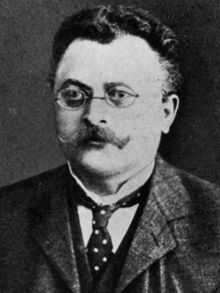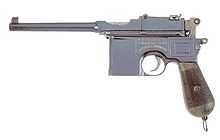Ernst August Wagner
| Ernst August Wagner | |
|---|---|
 Ernst August Wagner in 1909 | |
| Born |
September 22, 1874 Eglosheim, German Empire |
| Died |
April 27, 1938 Winnenthal, Nazi Germany |
Cause of death | Tuberculosis |
| Occupation | Teacher |
Criminal penalty | Found not guilty by reason of insanity |
| Killings | |
| Date | September 4, 1913 |
| Location(s) | Degerloch & Mühlhausen an der Enz, German Reich |
| Killed | 14 |
| Injured | 11 |
| Weapons |
Blackjack Dagger Two Mauser C96 |
Ernst August Wagner (September 22, 1874 – April 27, 1938) was a German mass murderer who, on September 4, 1913 killed his wife and four children in Degerloch. He subsequently drove to Mühlhausen an der Enz where he set several fires and shot 20 people, of whom at least 9 died, before he was beaten unconscious by furious villagers and left for dead.
He was the first person in Württemberg to be found not guilty by reason of insanity after several psychiatric assessments diagnosed him to suffer from paranoia. He was brought to an asylum in Winnenthal, where he commenced to write several plays and dramas. He died there of tuberculosis in 1938.[1]
Life
Ernst August Wagner was born on September 22, 1874 in Eglosheim near Ludwigsburg as the ninth of ten children, not including one half-brother and half-sister. Most of his siblings died early, so that in 1913 only two sisters and one brother remained. After his father, a poor peasant with drinking problems, died one day before Ernst Wagner's second birthday, the indebted family was forced to sell their farm. His mother tried to make a living by running a small shop; she soon remarried, but due to Mrs. Wagner's many affairs, the marriage ended in divorce when Ernst was seven years old.
Ernst Wagner, who was known as the "widow's boy" in the village, suffered from depression and suicidal thoughts,[2] though he was quite intelligent and did well enough at school to earn a public stipend. In this way, despite his poverty, he was able to study and become a teacher. After his qualifying exam, he worked as an auxiliary teacher at several schools in Württemberg from 1894 to 1901, though in April 1900 he was suspended for six months because of "severe nervousness and irritability". He then went to Switzerland for two months, where he tried to sell some of his poems to newspapers.
In July 1901, Wagner was assigned a teaching position in Mühlhausen an der Enz, where he stayed until 1902. Sometime in the summer of 1901, while drunk, he sodomized an animal. He then became increasingly wary and suspicious that others might be aware of his deed, and began to see signs and hints that the villagers of Mühlhausen were mocking him for this act of bestiality. For this reason, he bought a revolver, which he always carried with him from that point on so that he could evade a potential arrest.
That same year, Wagner began an affair with Anna Friedericke Schlecht, the daughter of a local innkeeper. He hated the Schlecht family, thinking that his future father-in-law despised him, and tried to avoid marrying Anna, but when she became pregnant by him and gave birth to a daughter, Klara, in the spring of 1902, marriage became a foregone conclusion.
In December 1902, Wagner's mother, to whom he felt deeply attached, died. He took his final examination as a teacher and was transferred to Radelstetten, a poor and isolated village. Although he was embittered to be ordered to such a puny place, it also temporarily eased his feelings of constant persecution, even though the incident of sodomy continued to haunt him. On December 29, 1903 he and Anna Schlecht married in Ludwigsburg, mostly due to pressure from outside, as their daughter Klara was already 10 months old. Ernst Wagner never made a secret out of the fact that he didn't love his wife anymore and thought that she was intellectually inferior to him, considering her to be more of a servant than his wife. Though Wagner's friends also stated that he always treated her kindly.[2]
In the summer of 1904 he once again went to Switzerland, trying twice to commit suicide there, once by drowning himself and by jumping off a bridge, though both attempts failed, because he was, according to his own words, too weak. In the following years his wife bore four more children, the last being Rudoplh Alfred Wagner, born in July 1909, who died on September 22 of the same year, Ernst Wagner's 35th birthday, who apparently was quite indifferent to the death of his son. Wagner was said to have been unhappy about the births of his children and complained about the financial stress the feeding of his large family caused.[2]
Some time in 1906 or 1907, thinking that the people from Mühlhausen had passed on their knowledge about his crime, the feelings of being ridiculed and watched by others returned, and as a consequence he began to make plans to take revenge on those whom he deemed to be the cause of his misery, the villagers, and especially the men, of Mühlhausen.[2] In autumn 1907 he bought the first Mauser pistol, the other one following in 1909 and, with his bicycle, which he loved more than anyone or anything else, he made extensive journeys through the surrounding area and trained his shooting skills in remote forests.
Between 1909 and 1911 he made several requests to be transferred to another school, which was finally granted, so that on May 1, 1912 he began his work at a school in Degerloch, a suburb of Stuttgart. At that time he also decided to go ahead with his plan to avenge the derision he had to endure, as even at his new workplace he saw hints of people "knowing", and initially chose the spring of 1913 to put it into practice, but finally determined the last days of the summer holidays for his revenge.[2] In the days leading to the murders he wrote several letters to explain his deed.[3]
Family murders
Wagner began his killing spree on September 4, 1913 at about 5 a.m., when he knocked his sleeping wife unconscious by hitting her on the head with a blackjack, before stabbing her numerous times in her throat and chest with a dagger, cutting her carotid arteries and hitting her heart and lungs. Afterwards he successively entered the bedrooms of his two sons, Robert and Richard, and his daughters, Klara and Elsa, and stabbed each of them in their throat and chest. Wagner initially claimed that he had also hit his children with the blackjack, though later he was uncertain of this. All of his victims died of massive haemorrhaging.
After covering his family members' bodies with blankets, Wagner got out of his blood-soaked nightshirt and washed himself, before packing a bag with three guns (two Mauser C96 and a small revolver), 500 rounds of ammunition, a black veil from his wife and a belt. He subsequently left his home, leaving a note at his own door that the family was jaunting to Ludwigsburg, as well as another one at the door of Mrs. Stepper, the proprietor of the house he was living in, ordering milk and leaving behind 35 pfennige as payment.
With his cycle he then drove towards Stuttgart and took a train to Ludwigsburg, where he bought a backpack, before making his way to his brother's home in Eglosheim, arriving there at about 11 a.m.
As his brother was not at home, Wagner chatted a while with his wife, telling her he wanted to spend the night at their home after fetching his children from Mühlhausen, and, as it could get late, the house should stay accessible to him during the night. In an unobserved moment he hid 228 rounds in a haystack in the garden. Wagner, accompanied by his nephew and niece, walked to the next train station, where he took a train to Bietigheim at about 1 p.m. From there he took off towards Großsachsenheim, where he mailed letters to several people, among them some of his relatives (one of them, addressed to his sister, simply reading "Take poison! Ernst" (Nimm Gift! Ernst)) and theologist and philosopher Christoph Schrempf, as well as a newspaper. Subsequently he returned to Bietigheim, where he got his bicycle checked by a mechanic and mailed two copies of his auto-biography, one again to Christoph Schrempf. At about 7 p.m. he left for Mühlhausen an der Enz.[4]
Shooting spree

Wagner reached the hills near Mühlhausen at about 11 p.m., where he girdled himself with the belt, put a cap on his head and took the two Mauser C96s, as well as a handbag containing ammunition, the black veil and a file. His bicycle and the small revolver were later found hidden in a corn field. Next Wagner set out to cut the telephone lines to the village, but as the poles looked too high to him and due to heavy rain that had set in by that time, he dropped that part of his plan and immediately went into Mühlhausen, where he set fire to four barns. The lower part of his face hidden with the veil he began walking through the streets, shooting at any male person that crossed his path. Wagner later claimed that his female victims were accidentally hit.
In total he spent about 80 rounds and shot 20 people, instantly killing eight of them, as well as two animals, and several buildings burned to the ground, before the villagers, with help of the military, managed to extinguish the fires. A ninth person, Jakob Knötzele, was mortally wounded and died a few hours after the shooting had ended. At one point Wagner forgot to reload his weapons and thus three men were able to strike him down with hoes and sabres. He suffered several wounds in his face and right hand, and his left hand was smashed and nearly cut off. Knocked unconscious, he was disarmed and left for dead, but at 2 a.m. a police officer found him lying on the street, still breathing. When he regained consciousness, Wagner immediately confessed to killing his family, and stated that he would have committed suicide in the end, but as this was now impossible, he would appreciate, if he'd be sentenced to death and decapitated.
Finally, in the evening of September 5, Wagner, who uttered concerns he might get ill if he'd stay too long in Mühlhausen, was brought to a hospital in Vaihingen, where his left forearm was amputated and his other wounds treated.[5]
Victims
|
|
|
See also
- Bremen school shooting, another German mass shooting by a teacher committed the same year
References
- ↑ Das Gehirn des Terrors, Spiegel Online (November 8, 2002)
- ↑ 2.0 2.1 2.2 2.3 2.4 Bruch, Hilde: Mass Murder: The Wagner Case
- ↑ Neuzner, Bernd & Brandstätter, Horst: Wagner - Lehrer, Dichter, Massenmörder. Frankfurt am Main: Eichborn, 1996 (pp. 53-61)
- ↑ Neuzner, Bernd & Brandstätter, Horst: Wagner - Lehrer, Dichter, Massenmörder. Frankfurt am Main: Eichborn, 1996 (pp. 18-23)
- ↑ Neuzner, Bernd & Brandstätter, Horst: Wagner - Lehrer, Dichter, Massenmörder. Frankfurt am Main: Eichborn, 1996 (pp. 23-30)
External links
- Mad teacher kills 15, wounds 16, The New York Times (September 6, 1913)
- Man who slew 15 insane, The New York Times (February 5, 1914)
- Massenmörder Wagner irrsinnig, Vorarlberger Volksblatt (February 6, 1914)
- Mass Murder - The Wagner Case
- Der Massenmord in Mühlhausen - Die Beerdigung der Opfer, Reichspost (September 9, 1913)
- Die Bluttat des Lehrers Wagner - Das letzte Verhör mit dem Mörder, Die Neue Zeitung (September 10, 1913)
- Ernst Wagner - Ein Lehrer, Dichter und Massenmörder
- Vom grausamen Mörder zum Dichter, Landesarchiv Baden-Württemberg (May 2, 2005)
|